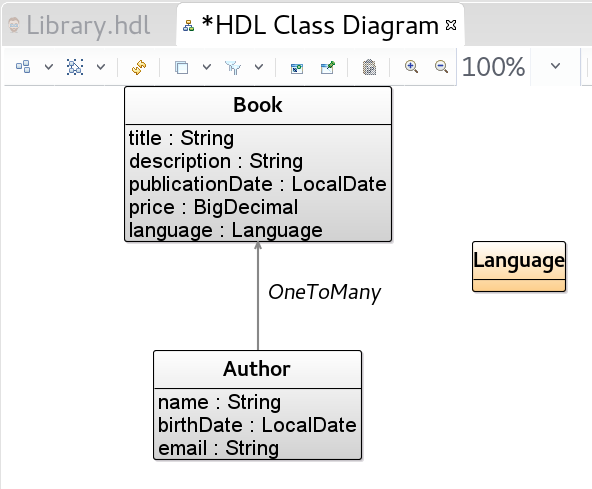Yet Another Hipster Domain Language (HDL)
Our own implementation of the JDL language, and more. Also, an opportunity to have a look at the Xtend programming language! Xtend itself is implemented in Xtext, so it's a good showcase of what can be achieved.
To get started, clone this repository on your filesystem.
Objectives:
- A textual editor in Xtext
- A graphical editor in Sirius
- Some tools around it, e.g. one that merges multiple JDL specifications into one
- Xtext can generate editors for IntelliJ IDEA and the Web. But because I know you love it, we will generate one for Eclipse ;)
Xtext
Step 0: clone this repository and import the projects it contains in Eclipse. (File -> Import -> Existing projects into workspace).
1 - Specifying the grammar
The central artifact of an Xtext project is the grammar specification (.xtext file). To get started, lookup and open the fr.inria.diverse.hdl/src/fr/inria/diverse/hdl/HipsterDomainLanguage.xtext file.
Have a look at the examples on the Xtext grammar language documentation to get you started.
Everytime you update the grammar of your DSL, you need to call Xtext's generator to re-generate the artifacts derived from the grammar (ie. the parser, the metamodel, etc). To do so, Right-click on your .xtext file -> Generate Xtext Artifacts.
It's now a good time to have a look at the generated metamodel. The Ecore file is located in the fr.inria.diverse.hdl/model/generated/HipsterDomainLanguage.ecore. The Java API derived from it is located in fr.inria.diverse.hdl/src-gen/fr/inria/diverse/hdl/hipsterDomainLanguage.
2 - Testing your new editor
Once the new artifacts are generated, they can be deployed as a set of plug-ins in a new Eclipse instance. To try your new editor, Right-click the project fr.inria.diverse.hdl -> Run as -> Eclipse Application. In the new Eclipse instance, create a new project (File -> New -> Project) and a new file with the extension .hdl within it. Xtext automatically binds your new editor to this file extension. Open your new file, and try to enter one of the sample domain model listed here. Then, repeat the operation until you're satisfied with your grammar specification.
3 - Custom validators
By default, Xtext generates an empty file fr.inria.diverse.hdl/src/fr/inria/diverse/hdl/validation/HipsterDomainLanguageValidator.xtend which is injected into the framework as a custom validator for your DSL. Below is a simple custom validator that checks whether each declared Entity starts with an uppercase, and issue a warning otherwise. The framework automatically calls this method when trying to validate an Entity.
class HipsterDomainLanguageValidator extends AbstractHipsterDomainLanguageValidator
{
@Check
def void checkEntityStartsWithUpperCase(Entity e) {
if (!Character::isUpperCase(e.name.charAt(0)))
warning(
// Message displayed to the user
'Entity name must start with an uppercase',
// Where to report the error? Here, on the 'name' feature of an 'Entity'
HipsterDomainLanguagePackage.Literals::ENTITY__NAME
)
}
}
Now, try to implement your own custom validation (ie. a new method annotated with @Check and a proper argument). For example, you can check that the names of the fields of an Entity are unique, or that the regex entered by the user are syntactically valid (using java.util.regex.Pattern::compile(regex)).
4 - A simple tool: merging two HDL specifications into one
Besides the facilities offered by Xtext, we would like to design an additional tool using the API provided by the EMF metamodel. If you select two HDL files and select "Merge", the empty fr.inria.diverse.hd/src/fr/inria/diverse/hdl/refactoring/DomainMerger::merge(Domain d1, Domain d2) method will be called. Try to implement this method by looking at the API provided by EMF. To create new elements (entities, relationships, etc.), have a look at the HipsterDomainLanguageFactory factory. The goal is to obtain a new domain model (and return it, it will be automatically serialized in the workspace as Merged.hdl) that:
- Contains the entities, enums and relationships declared in both .hdl ancestors
- If two entities have the same name, merge their fields
- Implement a basic support for conflict management (eg. the same entity with the same field's name having different types in both .hdl files)
5 - Bonus
Come back here when you're done with the next section :) Have a look at the IDE Concepts documentation and try to implement your own outline and quickfixes!
Sirius
Ok, so we've got a basic textual editor for JDL. But wouldn't it be more convenient to be able to visualize our entity-relation domain model graphically (ie. "boxes and arrows")?
When cloning the repository, you obtained a project fr.inria.diverse.hdl.design. Within it, you'll find a so-called 'Viewpoint Specification Model' description/hdl.odesign. This file specifies how the elements of a model (ie. your .hdl file) are projected as graphical elements. Additional documentation can be found at https://wiki.eclipse.org/Sirius/Tutorials/StarterTutorial and https://www.eclipse.org/sirius/doc/specifier/diagrams/Diagrams.html.
To get started, enter the Modeling perspective: Window -> Open Perspective -> Modeling and open the .odesign file. Also, open the Properties view which you'll use to customize your representation elements: Window -> Show View -> Properties.
In the .odesign, right-click on the 'Default' layer and create a new container diagram element. Give it a unique ID and select the domain element you want to represent. Then, right-click on your new container element and create a new style for it (for example, a gradient).
To test your new editor, restart the Eclipse instance that contains your .hdl files. Enter the modeling perspective right-click the project containing your test files -> Viewpoint selection and select the default viewpoint. Right-click again on the project and create a new representation for one of your .hdl model. Sirius will open a new graphical representation with the elements of your model.
Iterate between your .odesign and editor to obtain a representation you're comfortable with.

